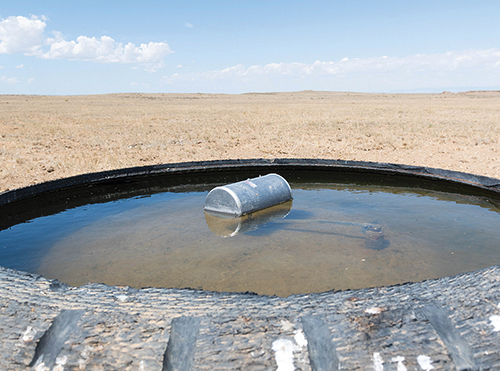 Original Article | Adriana Chávez | adchavez@nmsu.edu | January 16, 2023
Original Article | Adriana Chávez | adchavez@nmsu.edu | January 16, 2023
Johnny Francis, a member of the Navajo Nation, has been involved in ranching for most of his life, and hopes one day his family will take over the land he owns.
But the lack of water not just on his ranchland, but across the Navajo Nation, concerned him. Although he was lucky enough to have a windmill on his land to provide water to his herd of cattle without them having to walk too far, many ranchers had to haul huge tanks of water from miles away just to make sure their herd’s water tanks were filled.
“Water is important,” says Francis, who leases about nine square miles of land from the Navajo Nation and also owns 160 acres of private land. “I’ve seen people with tanks in the back of their trucks hauling water. It’s hard work.”
Mike Lisk, founder and CEO of Remote Well Solutions in Cloudcroft, New Mexico, decided to step in to help Navajo ranchers with a patented off-grid water production and distribution system, which replaces old windmills with solar and solar/generator hybrid-powered systems that operate automatically off grid to electrically pump water from wells, then distribute the water to multiple watering points.
“I have a cattle ranch in Lincoln County about the same size as the average tribal ranch, with 125 animal units. When I visit a Navajo Nation tribal ranch, I find they have better land with more forage than mine, but only have about 20 to 30 animal units,” Lisk says. “I have water distributed across my ranch, but they have one windmill and one water trough in one spot. Dramatic improvements in efficiency will result very quickly for the cattle, ranch and the rancher as the water challenges are solved. Quantifiable results will be almost immediate.”
Lisk worked with NMSU’s Arrowhead Center on a 2018 study on the economic impacts of the installation of the Remote Well Solutions systems in McKinley County. The study, written by Arrowhead Center Program Director Kramer Winingham ’08 ’10 ’13, Enterprise Advisor Dale Spencer and then-graduate student Ejiro Osiobe ’20, used an economic modeling software and found carrying capacities on ranches in McKinley County are four animal units per section on average.
In a likely scenario, carrying capacities increase 100% to eight animal units per section with the installed Remote Well Solutions technology. While this is still lower than typical New Mexico ranches, the project will help support more than 200 additional jobs in the state annually, and annually contribute nearly $18 million to the state’s economy.
“In terms of return on investment, this is one of the best economic development opportunities I’ve ever seen,” Winingham says. “The technology can double or triple the revenue potential of ranches in the area. It’s very exciting to see the Navajo Nation supporting the implementation of this new technology. The potential impact of Remote Well Solutions is significant in the Navajo Nation and beyond, as it can address challenges at similar ranches throughout the Southwest.”
“In the many years we have worked with Mike Lisk, we have been very impressed with his inventiveness and persistence to bring this new technology to market,” said Kathy Hansen, director and CEO of Arrowhead Center at NMSU. “We are excited to be able to help commercialize a New Mexico-developed technology that is solving real challenges in New Mexico.”
Remote Well Solutions is working with the Navajo Nation Department of Agriculture to break ground on additional projects within the eastern region of the Navajo Nation, which consists of regions in Utah, Arizona and New Mexico. In 2022, Remote Well Solutions received a $500,000 contract to build the wells after years of planning.
“Now that we’ve installed (Lisk’s system), it has really helped and I’m very pleased,” says Francis, who is authorized by the Navajo Nation to have 70 to 75 cows in his herd. “They’re spread out and look pretty decent. If we can prove that we’re really working the ranch, we can increase the herd and hopefully double it, as long as the tribe authorizes it.”